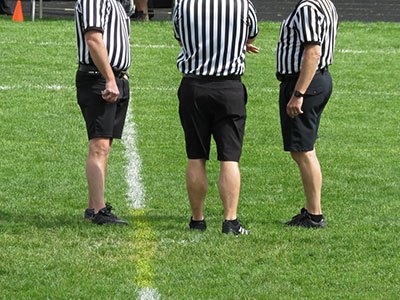Are you a lacrosse player looking to get off on the right foot? The coin toss makes for an important start to the game and can give your team the advantage and momentum it needs.
Understanding proper guidelines set in place by governing bodies is key, so let’s take a closer look at official rules and regulations around the lacrosse coin toss. With this knowledge, you’ll have all the info needed to create that perfect start!
More...
Take away key points:
If you want to know how each start and part of lacrosse begins, you can refer to the coin-tossing rules, and understand the concept better. Let's see the basic rules.
What is a coin toss procedure in lacrosse?
The coin toss procedure in lacrosse is an official procedure at the start of the game, or the start of overtime - when necessary, determining the key elements of the game during the play. It's crucial for players, officials, and coaches to understand the procedure for the best performance.
Regulation coin-tossing procedure

Before the game starts, lacrosse teams conduct warm-ups, revise game strategies with coaches, and prepare for the game on the side of the field adjusted to their team bench. Once the game clock shows five minutes remaining in the pregame period, the official will call the captains of the teams on the center line. The captains will shake hands.
The official tosses the coin and the captain winning the coin toss chooses the first alternate possession or defensive area. The alternate possession rule assigns the ball to one team, and then another one by alternative methods when the call cannot be decided in favor of one side.
The team losing the coin toss will choose the option the winning team did not choose. After the coin toss, the captains return to their teams for a final setup before the faceoff part of the game.
Overtime coin-tossing procedures
If the game is a tie result at the end of the regulation, the officials will perform another coin toss with the captains within a two-minute interval between the end of the second half and the beginning of the first overtime period.
The team winning the coin chooses the preferred defensive area. The alternating possession remains the same as in the regular part of the game.
Rules after the coin-tossing procedure
As the coin toss is only a part of the construction, there are other rules that players cannot violate. Let's see all of them.
1. Only the goalkeeper can touch the ball with his hands
The goalkeeper is the only person who can touch the ball with his hands, no other player is allowed to do so. Otherwise, they will violate the rules and will be awarded penalties for misconduct.
2. Possession of the ball
Body-checking a player in possession of the ball who is five yards of a loose ball is legal. However, body checking must be done above the waist or below the shoulders.
If a player performs an illegal body checking - above the shoulders, below the waist, the opponent does not have possession of the ball, or is further than five yards from a loose ball, the offending player receives a three-minute non-releasable penalty.
Due to personal fouls, the official blows the whistle and sends the offender into the penalty box. The offending team will play with nine instead of ten players.
3. Loose ball rules
A loose ball is a ball that is not in the possession of any player on the field. Players try to gain possession by scooping the ball off the ground. This is a method players perform to be successful.
The technique involves lowering the body and hands and using the stick like a shovel to scoop the ground ball.
Other lacrosse rules
Here are the basic lacrosse rules constituting the game. These include:
1. Field and equipment rules
Check out some of the field and equipment rules below:
- The lacrosse field measures 110x60 yards
- FXA supplies regulations for field and goals, all other equipment is the responsibility of the players
- Players wear jerseys with large numbers on the backs
- Goalkeepers wear protective gear including a chest pad and throat protector
- Players wear protective gear as well, with the helmet as the first part
- Players must have a legal lacrosse stick.
- Players wear arm pads, mouthguards, gloves, and shoulder pads.
2. Team rules
Check out some of the team rules below:
- Teams have a minimum of 10 players and a maximum of 25 players.
- Teams may have ten players on the field at one time divided into three defensemen, three midfielders, and three attackmen on the offensive half and defensive half of the field. The midfielders roam the entire field. The defensive player stays on the defensive end, while the offensive player remains on the offensive side of the field.
- If a team cannot have a minimum of eight players including a goalie on the field, they automatically forfeit.
3. Regulation rules

Check out some of the regulation rules below:
- Men's lacrosse has two 25-minute halves with a running clock, except in the last two minutes of the second half. The game uses a three-minute halftime.
- Each team gets one thirty-second timeout per each half in men's lacrosse. The teams have a two-minute break between the first and second quarters and the third and fourth quarters.
- Regular season games in men's lacrosse might end in a tie.
- Playoff games have three-minute sudden death overtime (officials conduct a visitors call, and coin toss and the winner chooses a side to defend, while the alternate possession remains as it was during the game.
- A tied result even after sudden death overtime calls for a Braveheart. Teams defend the same side as they were during overtime. Each lacrosse team sends on a goalie and one field player. A goalie might not cross the midfield line. Braveheart begins with a face-off. Braveheart does not allow substitutions. If after the first progress, the result is still a tie, other Braveheart will be played to determine the winner.
4. Game rules
Check out some of the game rules below:
- Lacrosse is a contact game played by ten or twelve players - for women's lacrosse. The main object of the game is to shoot the ball into the opponent's netting. The team scoring more goals wins.
- To begin play, the officials toss a coin and call visitors. The winning team chooses a defending side, or first alternate possession, while the loser gets the other option.
- Once teams establish the awarded possession, an advanced thirty-second count begins to get into their offensive box.
- Only the goalie can touch the ball with their hands.
- An attacking player cannot enter the crease but can be above the creasing or reach their stick to scoop a loose ball into the crease, or when shooting the ball.
- When the ball goes out of bounds, the other team is awarded possession. If the ball goes out of bounds after an unsuccessful shot, the player nearest the ball gains possession for his team.
- Any player committing five personal fouls is removed from the game.
- Fouls include unsportsmanlike conduct, unnecessary roughness, slashing, cross-checking, targeting the head, illegal body-checking, tripping, or unsportsmanlike conduct.
5. Player's (mis)conduct
Check out some of the player's (mis)conduct below:
- Body contact with the opponent is allowed to some point.
- Body checking the player with possession of the ball, or within five yards of a loose ball is legal.
- Checking must be below the shoulders and above the waist from the front side.
- There must not be any targeting of the neck or head with a cross-check. Violating the rules results in at least a three-minute -minute non-releasable penalty, and possible ejection.
- A player mustn't use his arms or hands to push the opponent with the ball.
- A player mustn't make contact with the goalkeeper in the crease.
- Stick check includes knocking the ball from an opponent's crosse with a stick. A defending player uses a stick for controlled poking or lifting another player's stick and gloved hands to dislodge the ball. If he hurts the opponent, the stick check will be illegal and the penalty is called upon the offender.
6. Face-off
Face-offs happen at the beginning of each half, after scoring each goal or Braveheart. The players wait until the main face-off player has gained possession to cross the wing area.
7. Offsides
Offsides take place when a team doesn't have at least four players on the defensive side or at least three players on the offensive side of the field.
FAQs
What does the coin toss determine in lacrosse?
The coin toss determines who gets possession of the ball to start the game.
Do you switch sides every quarter in lacrosse?
Yes, teams change sides every quarter.
Can lacrosse end in a tie?
Yes, the game can end in a tie, and then it's time for an overtime period or even Braveheart.
What sports use a coin toss?
Football, soccer, volleyball, etc. use a coin toss.
Conclusion
So, there you have it! The next time you're watching a game of lacrosse and wonder how the players decided who would start with the ball, now you know. It's all based on a coin toss!
While this may seem like a simple method, it's quite effective in ensuring that both teams have an equal opportunity to score from the very beginning.
